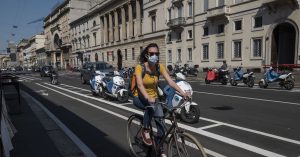Massive protests across the nation have sparked fears of a second wave of coronavirus cases as thousands of demonstrators gather close together, yelling and holding hands, all of which could amplify the transmission of the deadly virus.
But another problem has emerged in the past week that could also exacerbate the spread of COVID-19 in Los Angeles County: less testing.
Half of the approximately 40 government-run testing sites throughout the county have been shut down at some point since Saturday. On Wednesday, 15 were either still closed or operating with reduced hours due to remaining safety concerns or curfews, officials said.
It is unclear how much testing will drop due to the closures, but experts say that any reduction will hurt the region’s response to the virus. It will also heighten the dangers created by protesting as well as the reopenings of certain businesses that began last week, they said.
Advertisement
“Why did we stop doing this? We’re in the middle of a pandemic,” said Claire Garrido-Ortega, an epidemiology lecturer at Cal State Long Beach.
The closures have drawn ire from some residents, including demonstrators who have flooded the streets in recent days to speak up against police killings of black people. Many protesters pointed out that the coronavirus is also killing black people in disproportionately large numbers.
“It seems wildly irresponsible to close them now,” said Jack Moore, a TV writer who has attended multiple protests over the last week. There, protesters passed around hand sanitizer and wore masks, so closing the testing sites — another piece of combating the virus — felt like a slap in the face, he said.
Advertisement
Officials said the testing sites were closed due to safety concerns, following fires and looting over the weekend. Mayor Eric Garcetti, who made L.A. one of the first cities nationwide to offer universal testing, shuttered all city-run testing sites on Saturday afternoon, saying that volunteers were worried they were in danger.
“They didn’t feel safe and they wanted to leave,” Garcetti said at a news conference.
The city has kept Dodger Stadium, the biggest testing site, open since Monday, with additional sites reopening every day. People throughout the county who had testing appointments are being notified if their site is affected so they can reschedule, officials said.
“Los Angeles County is in the midst of fighting an unprecedented pandemic while also facing a state of emergency that impacts public safety,” Dr. Christina Ghaly, director of the county’s Department of Health Services, said in a statement. “We need to ensure our testing sites are safe for both patients and staff.”
Advertisement
Before the protests began, L.A. County had made significant progress reducing the spread and flattening, or even bending down, the curve. Late last week, officials announced that hair salons as well as restaurants could reopen with new safety regulations.
But the past five days have created circumstances that could undo much of that progress.
Reductions in testing mean less ability to identify sick people so they can be isolated and kept from getting other people sick. A large part of the reason cases climbed so quickly in March is a lack of widespread testing to control the epidemic, experts say.
Plus, the protests have led to large numbers of people congregating, standing close together and yelling, which creates opportunities for further spread of the virus, said UCLA epidemiologist Dr. Timothy Brewer.
Advertisement
“There will likely be an increase in cases,” he said. “But that has to be balanced against the fact that people are worried about other things too — they’re worried about democracy, and their ability to voice their opinions, and they’re worried about racial injustice.”
There is limited data so far on the impact of the closures on the county’s testing rates, which are typically among the highest in the nation. County figures do not suggest a decline in tests on Saturday, when many sites closed early, compared with the previous Saturday.
It is possible that the impact of closing some testing sites will be limited because many slots are regularly not filled.
Typically, only 60% of testing capacity is used across the county, with the rest unfilled or no-shows, according to county data. On Monday, Garcetti said that Dodger Stadium, which can test 6,000 people a day, could accommodate all appointments that had been made that day for sites across the city.
Advertisement
On Wednesday, there was capacity for 6,500 people to get tested at the county and state-run sites, compared with 7,000 people normally, and appointments remained available throughout the day, county officials said.
Even if capacity remains relatively unchanged, the closures are likely to drive down testing numbers simply because they’ve sown confusion about what is available, Garrido-Ortega said. In Long Beach, where she lives, the mayor announced last week that all asymptomatic people could get tested and then on Monday that all testing sites were closed.
“It’s a big mess,” she said.
Advertisement
The protests, which Garrido-Ortega said she supports, also seem to have shifted people’s attention away from COVID-19. She recalled hearing someone recently asked a friend, “Is the corona still around?”
Julie Vanderlee, 30, planned carefully before attending a protest in Long Beach on Sunday. She wore a mask and stayed on her bicycle so she could duck out if she felt she wasn’t able to keep enough space between her and others.
She was particularly upset when Long Beach officials suspended testing because of the protests. Officials said it was for the safety of the medical workers.
“These are protests for black lives, and black lives are disproportionately being impacted and ended by COVID-19,” she said. “My decision-making around [attending the protest] was around the fact that I knew there was free COVID testing available, and for that to be discontinued is very concerning.”


















